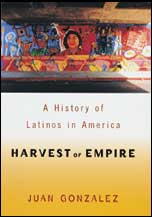 |
 |
 |
 |
|
COLUMBIA FORUM Hispanics are on track to become the largest minority group in the United States during the next decade and a full quarter of the population by 2050. In Harvest of Empire: A History of Latinos in America (Viking, $27), New York Daily News columnist Juan González, who entered with the Class of 1968, explores the origins and implications of the explosion of Latino peoples and cultures in the U.S. In this excerpt, González, who has been named one of the country's 100 most influential Hispanics by Hispanic Business and received a 1998 George Polk Journalism Award for Commentary, examines the consequences of free trade for Latin America.
North Americans at first ventured into Mexico, the Caribbean and Central America during the nineteenth century to buy up land and build massive transportation projects: Vanderbilt's Nicaraguan Transit Company, Minor Keith's Central American Railroad, Aspinwall's Panama Railroad, for example. By the early twentieth century, the main methods of exploitation had shifted to extracting raw materials - bananas, sugar, coffee, oil - and to financing the operations of Latin American governments. The region grew to be so important that by 1914, U.S. companies had $416 million in direct investments in Mexico alone, the highest of any country in the world, and Latin America overall accounted for nearly half of all U.S. foreign investment in the world. The period after World War II brought a third shift, as U.S. apparel, then electronics, plastics, and chemical companies, started closing down factories at home and reopening them abroad. That offshore production is at the heart of the free trade model the United States has promoted and perfected in Latin America.... As quickly as industrial plants were shuttered in the Northeast and Midwest, scores of shiny new industrial parks and factory towns, usually called free trade zones (FTZs) or export processing zones (EPZs), sprang up south of the border. By 1992, there were more than 200 of these zones in Mexico and the Caribbean Basin. They housed more than 3,000 assembly plants, employed 735,000 workers, and produced $14 billion in annual exports to the United States. These free trade zones were allowed to operate as virtual sovereign enclaves within the host countries, routinely ignoring the few local labor and environmental laws that existed. Inside the zones, child labor was reborn and the most basic rights of workers trampled. As agricultural production in many Latin American countries fell under the sway of foreign agribusiness, millions of Latin America's young people abandoned the countryside to find work in or near the zones. But the cities to which the migrants moved lacked infrastructures of roads, sewage systems, housing and schools to sustain the surge in population. Worker shantytowns sprang up overnight, and with the shantytowns and the factories came industrial pollution, untreated human waste, disease, crime - in short, a public health nightmare. Thus, free trade, which was supposed to stabilize the economies of the countries involved, has actually made conditions worse, and the free trade zones, instead of providing Latin Americans with living wage jobs, have probably fueled massive Latin American emigration to the United States. Typically, the young Latin American worker from the countryside arrives in the local city and finds work in a free trade zone in factories now commonly known as maquiladoras or maquilas. There, the worker is trained in rudimentary industrial skills -the rigors of assembly production, the discipline of time, the necessity for obedience to instructions. At night, the worker begins studying English in the scores of private language schools that abound in the new urban environment. He or she becomes immersed in American shows on the newly bought television - maquila workers in Honduras are more likely to own a television (67 percent) than non-maquila workers (60 percent); in fact, they are more likely to own a television than a stove (49 percent) or a refrigerator (24 percent). Each day, the worker devours the Spanish-language magazines and newspapers that are easily available in the cities and which glorify life in the United States. The worker quickly learns she can earn ten times the salary she gets in the maquila doing the same job in a factory across the border. Eventually, filled with her new consciousness and disgusted with her dead-end shantytown existence, the worker saves up the money to pay a coyote and risks the trip to El Norte.
The term "free trade" seems innocuous at first glance. Who could be against the idea that nations should seek the maximum freedom to trade with each other? Or that increased trade will bring with it increased prosperity? Unfortunately, the history of most major industrialized nations is just the opposite. None of them practiced free trade during their early period of economic growth. Instead, they used high tariffs to protect their domestic industries from foreign competition, often engaging in tariff wars against rivals. "In the early days, when British industry was still at a disadvantage, an Englishman caught exporting raw wool was sentenced to lose his right hand, and if he repeated the sin he was hanged," Uruguayan journalist Eduardo Galeano reminds us. Only when England gained a decided advantage over all other countries in world commerce did its government begin advocating free trade in the nineteenth century. During the early days of Latin American independence, England used the slogan to justify bullying the new criollo governments. In the 1850s, for instance, British and French warships sailed up the Rio Paraná to force the protectionist government of Argentine leader Juan Manuel de Rosas to open his country's prospering market to British bankers and traders. Eventually, the British concentrated on controlling the South American market, ceding control over most of the Caribbean region to the United States. In our own country, Congress pursued protectionist policies throughout the post-Civil War period, an era of extraordinary industrial growth for the nation. "In every year from 1862 to 1911, the average [U.S.] duty on all imports exceeded 20 percent...[and] in forty-six of those fifty years...[it] exceeded 40 percent," notes economist Alfred Eckes, who served on the International Trade Commission under President Reagan. Germany pursued a similar protectionist policy during its nineteenth-century industrial expansion. Not surprisingly, both the German and the U.S. economies experienced higher growth rates during that century than did England, the era's main proponent of free trade. Despite the historical record, most neoliberal economists in the advanced industrial nations continue to praise the fall of tariffs and the growth of free trade during the past few decades. They contrast the new open global marketplace to the "bad old days" of the 1970s, when Third World governments resorted to high tariffs to protect their own fledgling industries, a strategy called import substitution. But does expanded commerce automatically spur an increase in wealth, as the free traders say? And just who are the main beneficiaries of today's surge in international trading? Free trade proponents would have us believe this unfettered commerce is occurring between millions of businessmen in scores of countries and that the money changing hands is creating more and better-paid workers, who then have more money to consume, which, in turn, means that markets expand. But the reality is quite different. Two-thirds of all the trade in the world today is between multinational corporations, and one-third of it represents multinational corporations trading with their own foreign subsidiaries! A General Motors plant in Matamoros, for example, moves parts and finished cars between itself and the parent company in the United States; or Zenith ships machinery to expand one of its twelve assembly plants operating in Reynosa. Between 1982 and 1995, exports of U.S. multinational corporations more than doubled, but the portion of those exports that represented intracompany trading more than tripled. As a result of this enormous expansion of multinationals, the largest private traders and employers in Mexico today are not Mexican firms but U.S. corporations. Furthermore, if free trade leads to greater prosperity, why has economic inequality soared and poverty deepened in virtually every Third World country that adopted neoliberal free trade policies? According to the United Nations, the 225 richest people in the world had a net worth in 1997 equal to the income of 2.5 billion people, 47 percent of the world's population. Latin America now suffers from the most uneven distribution of wealth in its history. Before the 1980s, Latin Americans generally protected their domestic industries through heavy government ownership, high tariffs, and import substitution. Mexico pursued that policy from 1940 to 1980, and during that time, it averaged annual growth rates of more than 6 percent, with both manufacturing output and real wages for industrial workers growing consistently. But then came the debt crisis of the 1980s. Along with other Latin American countries, Mexico was gradually pressured by U.S.-controlled international financial institutions to adopt neoliberal, free trade policies. Those policies included selling public assets and increasing exports to pay down its debt. Between 1982 and 1992, the Mexican government sold off eleven hundred of fifteen hundred state-owned companies and privatized more than eighteen banks. This fire sale, instead of bringing prosperity, only deepened the chasm between rich and poor, as a new crop of Mexican billionaires emerged, real wages plummeted, and 200,000 Mexicans lost their jobs. From HARVEST OF EMPIRE: A HISTORY OF LATINOS IN AMERICA by Juan González. Copyright © Juan González, 2000. Used by permission.
|
|
|||||||||||||||||||||||||||||||||||||||||||||||||||||||||||||

